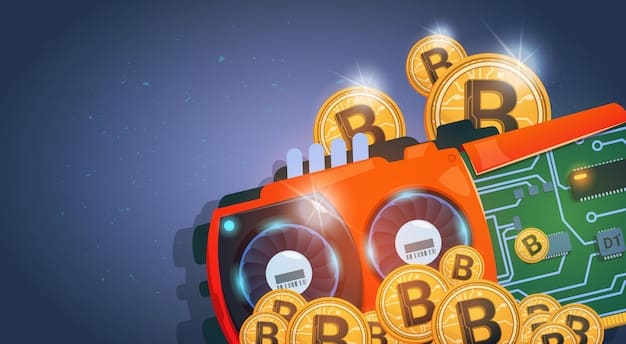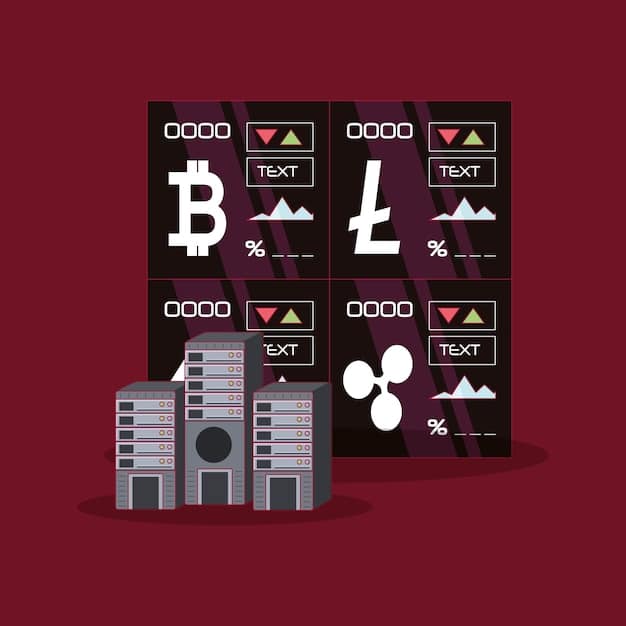Bitcoin Mining Pools: Top Choices for US Miners in 2024

Bitcoin mining pools offer US miners a collaborative approach to increase their chances of earning block rewards, with profitability varying based on pool fees, hash rate, payout methods, and the specific hardware used.
For US-based Bitcoin miners, choosing the right mining pool can significantly impact profitability. With numerous options available, each offering different fee structures, payout methods, and server locations, it’s crucial to make an informed decision. This guide explores the most profitable Bitcoin mining pools for US miners, considering factors like pool size, reward systems, and geographical proximity.
Understanding Bitcoin Mining Pools
Bitcoin mining, the process of verifying and adding new transactions to the blockchain, requires significant computational power. Solo mining, attempting to solve blocks independently, has become increasingly challenging and often unprofitable for individual miners. This is where Bitcoin mining pools come into play.
Mining pools are collaborative groups of miners who combine their computing resources to increase their chances of finding a block. When the pool successfully mines a block, the reward is distributed among the participants based on their contributed hash rate. This approach provides a more consistent and predictable income stream for miners, compared to the unpredictable nature of solo mining.

Benefits of Joining a Mining Pool
Joining a mining pool offers several advantages for US miners:
- Consistent Income: Pools provide a steady stream of revenue, making it easier to cover operational costs and plan for future investments.
- Reduced Variance: By pooling resources, miners reduce the volatility of their earnings, avoiding long periods without any rewards.
- Lower Entry Barrier: Mining pools allow individuals with less powerful hardware to participate in Bitcoin mining and earn rewards.
However, it’s also important to consider the drawbacks. Mining pools typically charge fees, which can reduce overall profitability. Miners also relinquish some control over the mining process and must trust the pool operator to fairly distribute rewards.
In conclusion, understanding the fundamental benefits and limitations of Bitcoin mining pools is crucial for US miners. By grasping these concepts, miners can strategically improve their chances of earning block rewards.
Factors to Consider When Choosing a Mining Pool
Selecting the most profitable Bitcoin mining pool for US miners involves carefully evaluating several key factors. These include the pool’s fee structure, hash rate, payout method, server location, and reputation.
Fee structures can vary significantly between pools, with some charging a percentage of the rewards earned, while others employ a flat fee or a pay-per-share (PPS) system. Similarly, payout methods differ, with options like PPS, full pay-per-share (FPPS), shared maximum pay-per-share (SMPPS), and proportional payouts. The most suitable method depends on individual preferences and risk tolerance.
Key Considerations for US Miners
For US-based miners, the following factors are particularly important:
- Server Location: Choosing a pool with servers located in North America can minimize latency and improve mining efficiency.
- Reputation and Transparency: Opting for a well-established pool with a proven track record ensures fair payouts and reliable operation.
- Hash Rate Distribution: A moderate hash rate distribution within the pool can help balance earning consistency and potential block discovery.
Beyond these, miners should also consider the pool’s user interface, customer support, and any additional features offered, such as mobile apps or detailed statistics. Thorough research and comparison are essential to finding the optimal mining pool for individual needs.
Ultimately, a judicious evaluation of these factors will empower US miners to select a Bitcoin mining pool aligned with their unique operational needs and revenue expectations.
Top Bitcoin Mining Pools for US Miners
Identifying the top Bitcoin mining pools for US miners requires a nuanced understanding of the available contenders. Several pools stand out due to their performance, reliability, and suitability for miners in the United States.
Some established pools like Foundry USA and Braiins Pool (formerly Slush Pool) are recognized for offering robust infrastructure, competitive fees, and reliable payouts. Others like Poolin and ViaBTC also provide attractive options for US miners, though their geographic focus may differ.

A Closer Look at Leading Pools
Here’s a brief overview of some of the leading Bitcoin mining pools for US miners:
- Foundry USA: Known for its strong presence in North America and support for various mining hardware.
- Braiins Pool (Slush Pool):One of the oldest pools, offering a transparent and reliable mining experience.
- Poolin: A globally recognized pool with competitive fees and diverse payout options.
It’s important to note that profitability can vary depending on network difficulty, Bitcoin price, and individual mining hardware. Miners should regularly evaluate their pool’s performance and make adjustments as needed to optimize their returns.
In conclusion, a selection of viable Bitcoin mining pools, with specific features around rewards and overall operation, sets the stage for US miners to engage and strategically improve profitability outcomes.
Comparing Profitability: Fees, Payouts, and Hash Rate
Assessing the true profitability of Bitcoin mining pools involves carefully comparing their fee structures, payout methods, and hash rates. These factors directly impact the amount of revenue miners can expect to earn.
Pool fees can range from 0% to 3% or higher, depending on the pool and the payout method used. Lower fees generally translate to higher profits for miners, but it’s essential to consider the pool’s overall performance and reliability.
Understanding Fee Structures
Different payout methods also have varying implications for profitability:
- PPS (Pay-Per-Share): Miners receive a fixed payment for each share they contribute, regardless of whether the pool finds a block.
- FPPS (Full Pay-Per-Share): PPS plus transaction fees distributed among miners.
- SMPPS (Shared Maximum Pay-Per-Share):Similar to PPS but caps payouts to prevent losses for the pool.
The pool’s hash rate also plays a role. A higher hash rate generally means the pool finds more blocks, but it also means the rewards are distributed among more miners. A balance between hash rate and miner count is ideal.
Ultimately, miners should carefully calculate their potential earnings based on these factors to determine which pool offers the best profitability for their specific mining setup.
Optimizing Your Mining Setup for Pool Mining
To maximize profitability when participating in Bitcoin mining pools, it’s essential to optimize your mining setup. This includes selecting the right hardware, configuring your mining software, and monitoring your performance.
The choice of mining hardware is crucial. Application-Specific Integrated Circuits (ASICs) are the most efficient and powerful mining devices currently available. Different ASICs have varying hash rates and power consumption, so it’s important to choose one that balances performance and energy efficiency.
Tips for Optimizing Your Mining Setup
Here are some additional tips for optimizing your mining setup:
- Use Efficient Cooling: Keep your mining hardware cool to prevent overheating and maintain optimal performance.
- Choose a Reliable Power Supply: Ensure your power supply can handle the power demands of your mining hardware.
- Monitor Your Hash Rate: Regularly monitor your hash rate to ensure your hardware is performing as expected.
Proper configuration of your mining software is also essential. Most mining pools provide specific instructions and configuration files for popular mining software like CGMiner or BFGMiner. Following these instructions carefully can help optimize your mining performance and ensure you receive accurate payouts.
To conclude, a fine-tune setup incorporating best practices, including monitoring and cooling systems, is essential for profitability.
Future Trends in Bitcoin Mining Pools
The landscape of Bitcoin mining pools is constantly evolving, with new technologies and trends emerging regularly. Understanding these trends can help US miners anticipate future changes and adapt their strategies accordingly.
One notable trend is the increasing decentralization of mining pools. Some new pools are designed to be more resistant to censorship and control by single entities. This trend is driven by a desire to maintain the decentralized nature of Bitcoin and prevent potential manipulation of the network.
Emerging Trends in Mining Pools
Here are some other emerging trends to watch:
- Green Mining: An growing emphasis on renewable energy sources for mining to reduce environmental impact.
- Stratum V2: A new mining protocol designed to improve efficiency and security.
- Decentralized Finance (DeFi) Integration: Some pools are exploring ways to integrate with DeFi platforms to offer additional rewards and services to miners.
Another trend is the increasing sophistication of mining hardware and software. As mining becomes more competitive, miners are constantly seeking ways to improve their efficiency and reduce their costs. This has led to the development of more advanced ASICs and mining software with features like automatic overclocking and power optimization.
In closing, strategic anticipation and tactical adaptations to future trends will be an ongoing element of success in the world of Bitcoin mining pools.
| Key Aspect | Brief Description |
|---|---|
| 💰 Profitability Factors | Fees, payout methods, and hash rate are key to a pool’s profitability. |
| ⚙️ Mining Setup Optimization | Hardware, cooling, and software settings must be optimized for the best returns. |
| 🌎 Server Location | Choosing a local server reduces latency and improves efficiency for US miners. |
| 📈 Future Trends | Decentralization and green mining are shaping the future of pools. |
Frequently Asked Questions
▼
A Bitcoin mining pool is a collaborative effort where miners combine their resources to increase the chances of finding a block and share the rewards.
▼
Payouts are typically proportional to the hash rate contributed by each miner. The pool distributes rewards after deducting fees based on the chosen payout method.
▼
Joining a mining pool provides a steadier income compared to solo mining, reduced variance in earnings, and a lower barrier to entry.
▼
US miners should focus onserver location, fees, payout methods, reputation, and security, and the pool’s hash rate distribution.
▼
Optimization includes using efficient hardware (ASICs), proper cooling, reliable power supplies, and consistently monitoring performance parameters.
Conclusion
Choosing the most profitable Bitcoin mining pool for US miners necessitates a thorough evaluation of fees, payout methods, hash rate, and emerging trends. By optimizing their mining setups and staying informed, miners can maximize their earnings in the ever-evolving Bitcoin landscape.





